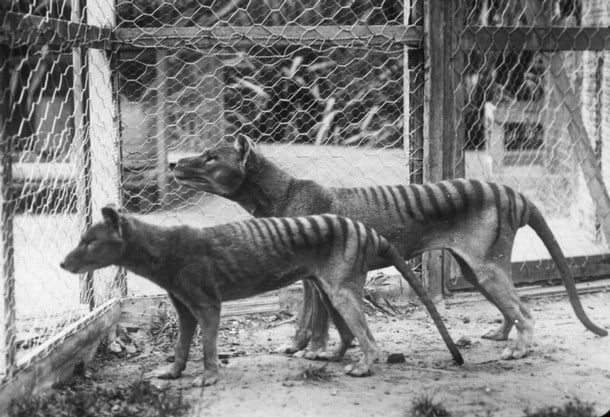What killed off the Tasmanian tiger? For a long time, it was believed this enigmatic marsupial went extinct due to being exterminated as a “pest” and competition with newly introduced dingoes. However, new research suggests there may have been another factor at play: the animal’s genetic diversity.
Tasmanian tigers, or Thylacines (Thylacinus cynocephalus), sometimes known as the Tasmanian wolf, were closely related to the Tasmanian devil (Sarcophilus harrisii). They were carnivores that sported a sandy cultured fur with distinct dark stripes running down their backs to their tails. For millions of years, the marsupial was native to the Australian mainland, Tasmania and New Guinea, but gradually they started to disappear, especially from the mainland. By the early 1800s, their numbers had already declined in Tasmania to around 5,000 as European settlers introduced new stressors to their environment.
The last known specimen died in Tasmania in 1936, and it is now believed that they are completely extinct. But the exact cause for this extinction has never been clear. Was it competition with dogs or was it human hunters who saw them as pests? Or could it have been something different? According to new genomic research, the Tasmanian tiger’s own genetics may have significantly contributed to their decline.

Adult and juvenile Tasmanian tigers at Hobart Zoo, Tasmania in 1928.
Image credit: Public Domain
The researchers tested their hypothesis by leveraging palaeogenomic data related to the Tasmanian tiger and compared it to genomic data of other marsupials, including Tasmanian devils. They did so by using machine learning-based comparative genomic tools to search for lost genes while also attempting to reconstruct when the animals lost genes using molecular evolutionary methods.
They found that Tasmanian tigers lost four genes – SAMD9L, HSD17B13, CUZD1, and VWA7 – sometime between 13 million and 1 million years ago. This was long before humans and dingoes arrived and began to interfere with their habitats.
“The thylacine genome exhibits the loss of four genes—SAMD9L, HSD17B13, CUZD1 and VWA7—each with important biological functions and implications for species fitness. Our investigation into the timing of gene loss events revealed a staggered pattern, occurring over a span of approximately 13−1 [million years ago],” the team explains in their paper.
“This temporal distribution,” they argue, “indicates that the gene losses were not confined to a single evolutionary event but occurred progressively after the Middle Miocene Climate Transition.”
The Middle Miocene Climate Transition occurred around 15 to 13 million years ago and was marked by significant ecological and climatic change. At the time, the Tasmanian tiger was smaller than it would later become and was unspecialized in terms of its diet. It is possible that the gene loss occurred as the animals began to undergo adaptive changes.
The four genes that they lost played crucial roles in the thylacine’s immune function, especially for their antiviral factors and tumor suppression. The researchers believe that a shift towards carnivory may have favored the loss of these genes, while also facilitating a larger body size. Taken together, the authors argue, the loss of these genes may have reduced the Tasmanian tiger’s fitness to thrive in their environment.
The team also found that the animals experienced a decrease in olfactory lobe size and a loss of olfactory receptor genes, which could mean they shifted away from using smell as a primary means for hunting. This could have been the result of their larger size and changes in their visual ability. Basically, as Tasmanian tigers got bigger, they could see their prey over obstacles that had previously obstructed their vision.
“Unlike the Tasmanian Devil, a scavenger, the taller thylacine likely depended on vision and sound for hunting, aided by its ability to see over vegetation,” the team explains.
Although these genetic changes may have helped the Tasmanian tiger in the (relative) short term, they may have ultimately led to their downfall.
“Whatever the cause for gene loss, the loss of SAMD9L, HSD17B13, CUZD1, and VWA7 genes in the thylacine possibly had negative pleiotropic effects, potentially compromising its health by affecting antiviral defence, metabolic processes, lactation, pancreatitis, and tumour susceptibility. Although model-based population viability analyses suggest that the disease played only a minor role in thylacine extinction, other studies suggest that a ‘canine-distemper-like’ disease played a role in exacerbating its extinction,” the team concludes.
The team believes their work offers a new framework for approaches to comparative genomics and ancestral gene loss. This, they argue, “could provide valuable insights into the causes of species extinction and offer clues about evolutionary processes, such as trait evolvability.”
It is possible that similar investigations into both existing and extinct species could offer a more comprehensive view of their past ecologies and trait evolution.
The paper is published in the Proceedings of the Royal Society.
Source Link: Tasmanian Tigers' Genetics May Have Doomed Them Long Before Humans Came Along